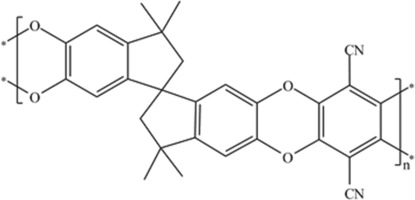当前位置:
X-MOL 学术
›
J. Membr. Sci.
›
论文详情
Our official English website, www.x-mol.net, welcomes your feedback! (Note: you will need to create a separate account there.)
Water desalination and biofuel dehydration through a thin membrane of polymer of intrinsic microporosity: atomistic simulation study
Journal of Membrane Science ( IF 9.5 ) Pub Date : 2018-01-01 , DOI: 10.1016/j.memsci.2017.09.057 Qi Shi , Kang Zhang , Ruifeng Lu , Jianwen Jiang
Journal of Membrane Science ( IF 9.5 ) Pub Date : 2018-01-01 , DOI: 10.1016/j.memsci.2017.09.057 Qi Shi , Kang Zhang , Ruifeng Lu , Jianwen Jiang

|
Abstract Polymers of intrinsic microporosity (PIMs) have emerged as a special class of polymeric materials and received considerable interest for many potential applications. Nevertheless, most current studies for PIMs are largely focused on gas separation. In this study, we report a simulation protocol to construct a thin membrane of PIM-1, examine its swelling in water and ethanol/water mixture, and explore its performance for water desalination via reverse osmosis as well as biofuel dehydration via pervaporation. The predicted density of the PIM-1 membrane matches well with experimental data. The estimated gravimetric and volumetric swelling degrees are in accord with measured values. As ethanol has a greater capability than water to swell the membrane, the void distribution of the membrane is found to shift to a larger size in ethanol/water mixture than in water. For water desalination, the membrane exhibits water permeability of 8.6 × 10 −7 kg·m/(m 2 ·h·bar) and 100% salt rejection, which is higher than commercial reverse osmosis membranes. For the dehydration of ethanol/water mixture, water permeability and separation factor are 5 × 10 −5 kg·m/(m 2 ·h·bar) and 25, respectively, surpassing poly(vinyl alcohol) and polybenzimidazole membranes. This simulation study provides microscopic insights into the structural and separation properties of PIM-1 membrane from the bottom-up, and suggests that PIM-1 membrane might be an interesting candidate for water desalination and biofuel dehydration.
中文翻译:

通过固有微孔聚合物薄膜的水淡化和生物燃料脱水:原子模拟研究
摘要 固有微孔 (PIM) 聚合物已成为一类特殊的聚合物材料,并在许多潜在应用中引起了极大的兴趣。尽管如此,目前大多数关于 PIM 的研究主要集中在气体分离上。在这项研究中,我们报告了构建 PIM-1 薄膜的模拟协议,检查其在水和乙醇/水混合物中的膨胀,并探索其通过反渗透进行水淡化以及通过渗透蒸发进行生物燃料脱水的性能。PIM-1 膜的预测密度与实验数据匹配良好。估计的重量和体积溶胀度与测量值一致。由于乙醇比水具有更大的膜膨胀能力,发现膜的空隙分布在乙醇/水混合物中比在水中转移到更大的尺寸。对于海水淡化,该膜表现出 8.6 × 10 -7 kg·m/(m 2 ·h·bar) 的透水率和 100% 的脱盐率,高于商业反渗透膜。对于乙醇/水混合物的脱水,水渗透率和分离因子分别为5×10 -5 kg·m/(m 2 ·h·bar)和25,超过了聚乙烯醇和聚苯并咪唑膜。该模拟研究提供了自下而上对 PIM-1 膜的结构和分离特性的微观见解,并表明 PIM-1 膜可能是海水淡化和生物燃料脱水的有趣候选者。6 × 10 -7 kg·m/(m 2 ·h·bar) 和 100% 脱盐率,高于商业反渗透膜。对于乙醇/水混合物的脱水,水渗透率和分离因子分别为5×10 -5 kg·m/(m 2 ·h·bar)和25,超过了聚乙烯醇和聚苯并咪唑膜。该模拟研究提供了自下而上对 PIM-1 膜的结构和分离特性的微观见解,并表明 PIM-1 膜可能是海水淡化和生物燃料脱水的有趣候选者。6 × 10 -7 kg·m/(m 2 ·h·bar) 和 100% 脱盐率,高于商业反渗透膜。对于乙醇/水混合物的脱水,水渗透率和分离因子分别为5×10 -5 kg·m/(m 2 ·h·bar)和25,超过了聚乙烯醇和聚苯并咪唑膜。该模拟研究提供了自下而上对 PIM-1 膜的结构和分离特性的微观见解,并表明 PIM-1 膜可能是海水淡化和生物燃料脱水的有趣候选者。超过聚(乙烯醇)和聚苯并咪唑膜。该模拟研究提供了自下而上对 PIM-1 膜的结构和分离特性的微观见解,并表明 PIM-1 膜可能是海水淡化和生物燃料脱水的有趣候选者。超过聚(乙烯醇)和聚苯并咪唑膜。该模拟研究提供了自下而上对 PIM-1 膜的结构和分离特性的微观见解,并表明 PIM-1 膜可能是海水淡化和生物燃料脱水的有趣候选者。
更新日期:2018-01-01
中文翻译:

通过固有微孔聚合物薄膜的水淡化和生物燃料脱水:原子模拟研究
摘要 固有微孔 (PIM) 聚合物已成为一类特殊的聚合物材料,并在许多潜在应用中引起了极大的兴趣。尽管如此,目前大多数关于 PIM 的研究主要集中在气体分离上。在这项研究中,我们报告了构建 PIM-1 薄膜的模拟协议,检查其在水和乙醇/水混合物中的膨胀,并探索其通过反渗透进行水淡化以及通过渗透蒸发进行生物燃料脱水的性能。PIM-1 膜的预测密度与实验数据匹配良好。估计的重量和体积溶胀度与测量值一致。由于乙醇比水具有更大的膜膨胀能力,发现膜的空隙分布在乙醇/水混合物中比在水中转移到更大的尺寸。对于海水淡化,该膜表现出 8.6 × 10 -7 kg·m/(m 2 ·h·bar) 的透水率和 100% 的脱盐率,高于商业反渗透膜。对于乙醇/水混合物的脱水,水渗透率和分离因子分别为5×10 -5 kg·m/(m 2 ·h·bar)和25,超过了聚乙烯醇和聚苯并咪唑膜。该模拟研究提供了自下而上对 PIM-1 膜的结构和分离特性的微观见解,并表明 PIM-1 膜可能是海水淡化和生物燃料脱水的有趣候选者。6 × 10 -7 kg·m/(m 2 ·h·bar) 和 100% 脱盐率,高于商业反渗透膜。对于乙醇/水混合物的脱水,水渗透率和分离因子分别为5×10 -5 kg·m/(m 2 ·h·bar)和25,超过了聚乙烯醇和聚苯并咪唑膜。该模拟研究提供了自下而上对 PIM-1 膜的结构和分离特性的微观见解,并表明 PIM-1 膜可能是海水淡化和生物燃料脱水的有趣候选者。6 × 10 -7 kg·m/(m 2 ·h·bar) 和 100% 脱盐率,高于商业反渗透膜。对于乙醇/水混合物的脱水,水渗透率和分离因子分别为5×10 -5 kg·m/(m 2 ·h·bar)和25,超过了聚乙烯醇和聚苯并咪唑膜。该模拟研究提供了自下而上对 PIM-1 膜的结构和分离特性的微观见解,并表明 PIM-1 膜可能是海水淡化和生物燃料脱水的有趣候选者。超过聚(乙烯醇)和聚苯并咪唑膜。该模拟研究提供了自下而上对 PIM-1 膜的结构和分离特性的微观见解,并表明 PIM-1 膜可能是海水淡化和生物燃料脱水的有趣候选者。超过聚(乙烯醇)和聚苯并咪唑膜。该模拟研究提供了自下而上对 PIM-1 膜的结构和分离特性的微观见解,并表明 PIM-1 膜可能是海水淡化和生物燃料脱水的有趣候选者。



























 京公网安备 11010802027423号
京公网安备 11010802027423号